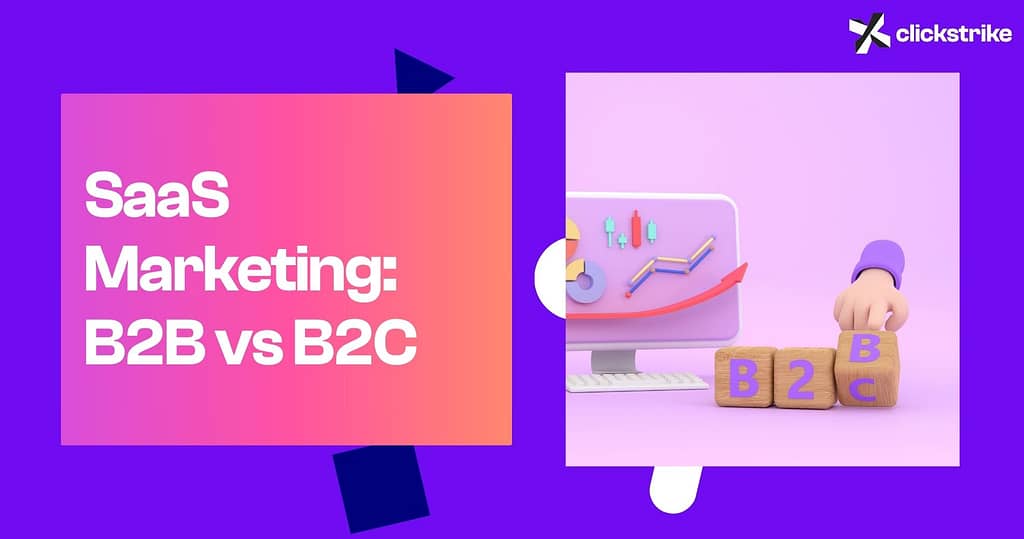When it comes to marketing software-as-a-service (SaaS) products, understanding the differences between B2B and B2C strategies is crucial. While both aim to attract and retain users, the approach, messaging, and channels must be tailored to meet the distinct needs of each audience. In this post, we’ll dive into the key differences between B2B SaaS marketing vs B2C, and explore how you can adapt your strategies to effectively target and engage each audience type.
Understanding B2B SaaS Marketing
Definition and Characteristics of B2B SaaS Marketing
B2B SaaS marketing focuses on selling software solutions to businesses, organizations, or enterprises. The primary goal is to demonstrate how your product can solve specific business pain points, improve efficiency, and deliver a strong return on investment (ROI). The decision-making process in B2B is typically more complex, involving multiple stakeholders who must be convinced of the product’s value.
Also Read: Top B2B SaaS Marketing Agencies
Common Challenges in B2B SaaS Marketing
Marketing to businesses presents unique challenges:
- Longer Sales Cycles: B2B sales often take months or even years, as businesses thoroughly evaluate potential solutions.
- Multiple Stakeholders: Decisions are usually made by a group, each with different priorities and concerns.
- High-Touch Customer Support: Building strong relationships and providing ongoing support is essential to winning and retaining customers.
Key Strategies for B2B SaaS Marketing
To succeed in B2B SaaS marketing, consider these strategies:
- Content Marketing: Develop in-depth whitepapers, case studies, and blogs that demonstrate your product’s value and address industry-specific challenges.
- Account-Based Marketing (ABM): Tailor your messaging and outreach to specific accounts, focusing on the unique needs of each business.
- LinkedIn and Industry Platforms: Use LinkedIn and other industry-specific platforms for targeted lead generation and thought leadership.
Understanding B2C SaaS Marketing
Definition and Characteristics of B2C SaaS Marketing
B2C SaaS marketing is geared toward individual consumers or small teams, with an emphasis on user experience, ease of use, and emotional appeal. The focus is often on how the product simplifies life, enhances productivity, or provides entertainment.
Common Challenges in B2C SaaS Marketing
While the audience is broader, B2C SaaS marketing has its own set of challenges:
- High Competition: The market is saturated with options, making it difficult to stand out.
- Rapid Customer Acquisition and Retention: Success depends on quickly acquiring users and keeping them engaged.
- Pricing Sensitivity: Consumers often expect free trials or freemium models, making pricing a critical factor.
Key Strategies for B2C SaaS Marketing
Effective B2C SaaS marketing strategies include:
- Social Media Marketing: Leverage platforms like Instagram, Facebook, and TikTok to reach a wide audience, and consider influencer partnerships to build trust.
- User-Centric Content: Create educational resources such as tutorials and how-to videos that highlight the ease of use and benefits of your product.
- A/B Testing: Continuously optimize your conversion funnels through testing to improve sign-up rates and user retention.
Comparing B2B SaaS Marketing vs B2C
Sales Cycle Length and Complexity
- B2B: Sales cycles are longer and more complex, with multiple touchpoints and decisions made by committee. Patience and persistence are key.
- B2C: Sales cycles are typically shorter, with quicker decision-making processes often driven by impulse or immediate need.
Messaging and Positioning
- B2B: Messaging is value-driven, focusing on ROI, efficiency, and solving specific business challenges. It’s often more technical and detailed.
- B2C: Messaging is emotion-driven, focusing on the direct benefits to the user, such as convenience, enjoyment, or productivity. Simplicity is crucial.
Lead Generation and Nurturing
- B2B: Lead generation focuses on relationship-building and nurturing leads over time through personalized content and direct outreach.
- B2C: Lead generation targets a broad audience, aiming for quick conversions with automated nurturing sequences that guide users through the funnel.
Customer Retention Strategies
- B2B: Retention strategies involve providing ongoing support, customer success management, and fostering long-term relationships with clients.
- B2C: Retention focuses on keeping users engaged with in-app updates, loyalty programs, and continuous value delivery.
Case Studies and Examples
Example 1: Successful B2B SaaS Marketing Campaign
A leading CRM software company implemented an account-based marketing strategy, targeting key decision-makers within large enterprises. By delivering personalized content and engaging in direct outreach, they successfully shortened the sales cycle and closed several high-value deals. The key takeaway? Personalization and targeted efforts can significantly impact B2B success.
Example 2: Successful B2C SaaS Marketing Campaign
A popular personal finance app launched a social media campaign leveraging influencer partnerships. By creating relatable content that highlighted the app’s benefits in managing day-to-day finances, they quickly grew their user base and saw a substantial increase in free-to-paid conversions. The lesson here is the power of emotional appeal and relatability in B2C marketing.
How to Adapt Your Strategy
Identifying Your Target Audience
The first step in crafting an effective SaaS marketing strategy is understanding your audience. Are you targeting businesses with specific needs, or individual consumers looking for convenience and ease of use?
Customizing Your Approach
Once you’ve identified your audience, tailor your approach accordingly:
- For B2B: Focus on value-driven content, personalized outreach, and building long-term relationships.
- For B2C: Emphasize ease of use, emotional appeal, and create a seamless user experience from acquisition to retention.
Testing and Iteration
Regardless of your target audience, continuously testing and refining your strategies is essential. Use A/B testing to optimize your messaging, user interface, and conversion processes.
Leveraging Data and Analytics
Data-driven decisions are crucial in both B2B and B2C marketing. Leverage analytics to track user behavior, identify areas for improvement, and measure the effectiveness of your campaigns.
Conclusion
Understanding the differences between B2B SaaS Marketing vs B2C is key to developing strategies that resonate with your audience and drive growth. By tailoring your approach to the unique characteristics of each market, you can optimize your efforts and achieve greater success. Whether you’re in the process of refining your current strategy or exploring new markets, these insights will help you navigate the complexities of SaaS marketing with confidence.

 Book A Call
Book A Call